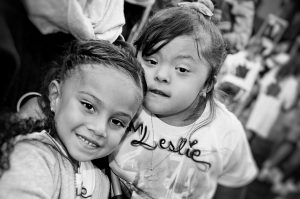13 Down Syndrome
Just like everyone else, students with Down syndrome have their own abilities, strengths, and weaknesses. They might have some additional needs, but they also have many of the same needs as other students in their age group.
Down syndrome is a naturally occurring chromosomal arrangement that has always existed and crosses all racial, gender, and socio-economic lines.

Approximately one in every 781 babies born in Canada has Down syndrome.
Three are three types of Down syndrome: The type is identified from the chromosome studies done at birth to confirm the diagnosis of
Down syndrome:
- Trisomy 21 is the most common type of Down syndrome- it includes 95% of the Down syndrome population.
- Translocation occurs in 2-3% of those born with Down syndrome, where an extra part or whole extra copy of chromosome 21 is attached to a different chromosome.
- Mosaicism is the least common type of Down syndrome. In about one percent of children with Down syndrome there is an extra whole chromosome 21 in only a percentage of their body cells- the rest of the cells do not have the extra chromosome.
No matter which type of Down syndrome the student has, the effects of the extra genetic material will be unique to them. They will have their own strengths, likes, dislikes, talents, personality, and temperament. Down syndrome is just part of who they are.
People with Down syndrome have:
- Some intellectual disability
- Some delay in development which may include speech and motor skills
- Some characteristic physical features, including a recognizable facial appearance and short stature
People with Down syndrome might look similar and share some common physical features. But most of all, they will look like their family members and will have their own unique personality. With new medical interventions and treatment, most people with Down syndrome can live healthy lives. There is no definitive life span and some people with Down syndrome now live well into their 70s.
Physical and Health Conditions
Students with Down syndrome may experience issues related to their health and this can affect their classroom experiences and attendance. Some students may have chronic health needs, others will have occasional needs, and some will be as healthy as any other student in your classroom.
When a student with Down syndrome joins your classroom, review the student’s file and talk to the parents about their medical history. Determine if there are any precautions or supports needed. If a student is taking medication, find out what it is and how it works. If you see any signs or changes, communicate with the parents and inform them of what you are seeing.
Some health concerns for people with Down syndrome may include:
- Congenital heart conditions
- Gastrointestinal issues
- Increased risk of developing childhood leukemia
- Respiratory infections
- Sleep issues
- Thyroid problems
- Vision and hearing problems
Watch What is Down Syndrome? by Down Syndrome Resource Foundation Canada (DSRFC) via YouTube,
Watch Down Syndrome – Ability Awareness about Down Syndrome from the National Down Syndrome Society:
Unit Attribution
Adapted from About Down Syndrome :Quick Guide by the Canadian Down Syndrome Society

